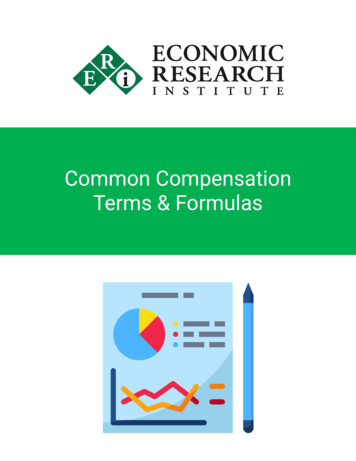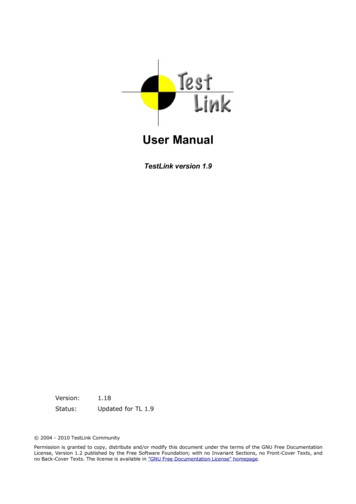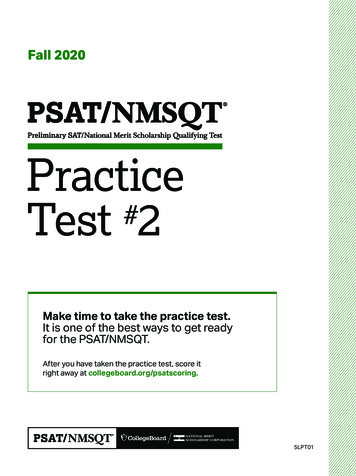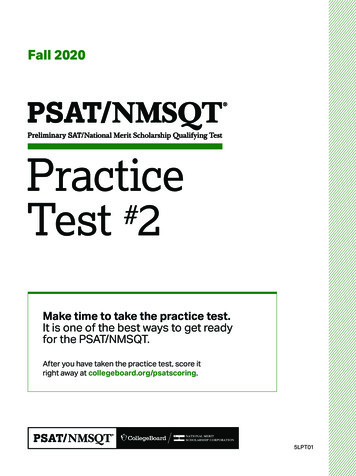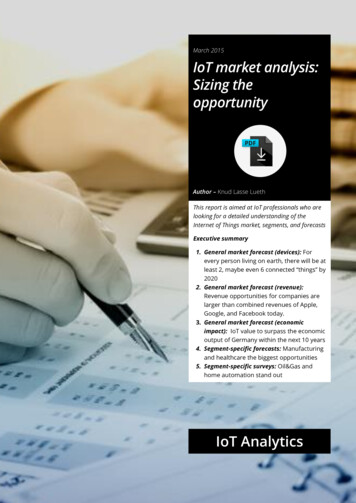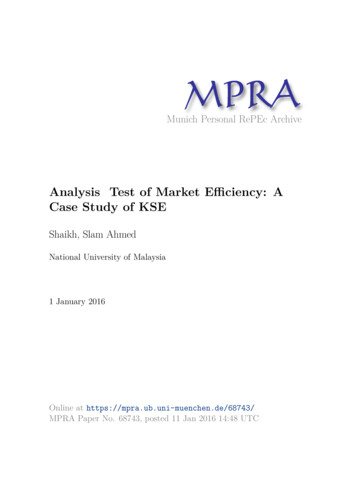
Transcription
Munich Personal RePEc ArchiveAnalysis Test of Market Efficiency: ACase Study of KSEShaikh, Slam AhmedNational University of Malaysia1 January 2016Online at https://mpra.ub.uni-muenchen.de/68743/MPRA Paper No. 68743, posted 11 Jan 2016 14:48 UTC
Analysis & Test of Market Efficiency: A Case Study of KSESalman Ahmed Shaikh1AbstractThis study employs more recent and comprehensive data (1997-2013) for the empiricalverification of weak form efficiency in Karachi Stock Exchange (KSE). We useAugmented Dickey Fuller (ADF) and Philips-Perron (PP) tests to detect unit root in thedaily returns series. Further, we run Random Walk Model (RWM) to detect unit root inreturns series. We use Runs test to detect any possible serial correlation in residuals.Results are in support of weak form efficiency. However, the study argues that strongform efficiency does not exist in KSE. We compare equity funds returns with KSE 100Index returns for 10 years (2003-2012) and we find that the mean returns and standarddeviations are not much different. However, the correlation between the returns is foundto be low which indicates that equity funds do not mimic market index and have veryconcentrated portfolios comprising of growth stocks. Finally, we also compare thereturns and Sharpe ratio for Islamic and conventional equity mutual funds. Since Islamicfunds due to investment and trading restrictions can not exactly mimic market portfolio,the return comparison could help in studying whether the contention of EMH proponentsthat expert investors too can do as good as earning returns on market portfolio isentirely valid or are there some qualifications and exceptions. We report evidence thatchallenges the EMH proposition.Keywords Market Efficiency, Weak Form Efficiency, Strong Form Efficiency, CapitalMarkets, Volatility, Asset Pricing Models, Investor Behavior, Emerging MarketsJEL Codes G11, G12, G141. Introduction: Market Efficiency1.1.DefinitionFama (1965) coined the phrase “efficient markets” and defined market efficiency asfollows:"In an efficient market, competition among the many intelligent participantsleads to a situation where, at any point in time, actual prices of individualsecurities already reflect the effects of information based both on eventsthat have already occurred and on events which, as of now, the marketexpects to take place in the future. In other words, in an efficient market atany point in time, the actual price of a security will be a good estimate ofits intrinsic value."1Salman Ahmed Shaikh is Research Associate at IBA, Karachi and faculty member in Department of Economics, atIBA. He is pursuing his PhD in Economics. He can be contacted at: salmanashaikh@iba.edu.pk
A market is efficient with respect to information set if it is impossible to make economicprofits by trading on the basis of information set. (Jensen, 1978)Efficient markets do not imply that investors cannot earn a positive return in the stockmarket. But, efficient markets do imply that on average, investors will earn a return thatis appropriate for the risk undertaken and there is no bias in prices that can be exploitedto earn excess returns.1.2.Forms of Market Efficiency1.2.1. Weak Form EfficiencyIn weak-form efficiency, future prices cannot be predicted by analyzing prices from thepast. Excess returns cannot be earned in the long run by using investment strategiesbased on historical share prices or other historical data. Technical analysis techniqueswill not be able to consistently produce excess returns, though some forms offundamental analysis may still provide excess returns.1.2.2. Semi-Strong Form EfficiencyIn semi-strong-form efficiency, it is implied that share prices adjust to publicly availablenew information very rapidly and in an unbiased fashion, such that no excess returnscan be earned by trading on that information. Semi-strong-form efficiency implies thatneither fundamental analysis nor technical analysis techniques will be able to reliablyproduce excess returns. Neither technical nor fundamental analysis can be used to beatthe market consistently on risk-adjusted basis.1.2.3. Strong Form EfficiencyIn strong-form efficiency, share prices reflect all information, public and private, and noone can earn excess returns. It implies that even insiders cannot beat the marketconsistently. Evidence is usually against strong form efficiency even in developedmarkets.1.3. Salient ImplicationsPeople process data appropriately and correctly.People view all decisions through the transparent and objective lens of risk andreturn.People are guided by reason and logic and independent judgment.Market price of a security is an unbiased estimate of its intrinsic value.Market prices reflect rational expectations.Ex ante, expected abnormal returns are zero.
Current price reflects all current information. Price changes must be due to newunexpected information arriving. Unexpected information is a chance event, i.e.random and hence price changes away from expected values are also random.2. Evidence on Efficiency in Developed Markets2.1.Literature in Favor of Market EfficiencyIn the early years of Efficient Market Hypothesis (EMH), Jensen (1978) exclaimed thatthere is no other proposition in economics which has more solid empirical evidencesupporting it than the EMH. That hypothesis has been tested and, with very fewexceptions, found consistent with the data in a wide variety of markets: the New Yorkand American Stock Exchanges, the Australian, English, and German stock markets,various commodity futures markets, the Over-the-Counter markets, the corporate andgovernment bond markets, the Options market, and the market for seats on the NewYork Stock Exchange.In favor of market efficiency, Fama (1998) concludes that consistent with the marketefficiency hypothesis that the anomalies are chance results, apparent overreaction toinformation is about as common as under reaction and post-event continuation of preevent abnormal returns is about as frequent as post-event reversal. Most importantly,consistent with the market efficiency prediction that apparent anomalies can be due tomethodology, most long-term return anomalies tend to disappear with reasonablechanges in technique.He further argues that in an efficient market, apparent under reaction will be about asfrequent as overreaction. If anomalies split randomly between under reaction andoverreaction, they are consistent with market efficiency.Jensen (1968) analyzing 115 mutual funds over the period 1955-64 concludes that on arisk-adjusted basis, any advantage that the portfolio managers might have is consumedby fees and expenses. Even if investment management fees and loads are added backto performance measures, and returns are measured gross of management expenses,Jensen concludes that on average the funds apparently were not quite successfulenough in their trading activities to recoup even their brokerage expenses.Roll (1994) observes that it is remarkably hard to profit from even the most extremeviolations of market efficiency. Stock market anomalies are only too often chanceevents that do not persist into the future.If anomalies can be exploited, then the expert fund managers and analysts shall be ableto beat the market often enough. Using bootstrap simulations, Fama & French (2010)investigated 3,156 funds in their sample and suggested that few funds producebenchmark-adjusted expected returns sufficient to cover their costs. Some doextraordinarily well and some do extraordinarily poorly just by chance.
In another study, Odean (1999) finds that momentum investors do not realize excessreturns.In general, RWM of returns had not been refuted in most studies. Even where it hadbeen refuted, the evidence has to be interpreted with a grain of salt because of the dualhypothesis problem discussed in next section. There has been favorable evidence forweak form & semi strong form based on event studies. Fama (1998) surveys theconsiderable body of empirical work on “event studies” that seeks to determine if stockprices respond efficiently to information. The “events” include such announcements asearnings surprises, stock splits, dividend actions, mergers, new exchange listings, andinitial public offerings.We must appreciate that the notion of efficiency encompasses informational efficiencyand not necessarily transactional and operational efficiency.Regarding the existence and evidence in favor of market and behavioral anomalies, onemust note that an anomaly discussed means that it is known. It is less likely to do thesame next time because others will be watching for it as well.Anomalies are empirical results that seem to be inconsistent with maintained theories ofasset-pricing behavior. They indicate either market inefficiency (profit opportunities) orinadequacies in the underlying asset-pricing model. After they are documented andanalyzed in the academic literature, anomalies often seem to disappear, reverse, orattenuate. This raises the question that whether profit opportunities of the past havesince been arbitraged away, or whether the anomalies were simply statisticalaberrations that attracted the attention of academics and practitioners.According to EMH proponents, the random errors of investors cancel out in the market.This requires individual errors (departures from individual rationality) to be crosssectionally independent or at least only weakly correlated.Fama (1998) finds that apparent under reaction to information is about as common asoverreaction, and post-event continuation of abnormal returns is as frequent as postevent reversals. He also shows that many of the return “anomalies” arise only in thecontext of some very particular model, and that the results tend to disappear whenexposed to different models for expected “normal” returns, different methods to adjustfor risk, and when different statistical approaches are used to measure them. Forexample, a study, which gives equal-weight to post-announcement returns of manystocks, can produce different results from a study that weight the stocks according totheir value. Certainly, whatever momentum that is displayed by stock prices, it does notappear to offer investors a dependable way to earn abnormal returns.Momentum strategies, which refer to buying stocks that display positive serialcorrelation and/or positive relative strength, appeared to produce positive relativereturns during some periods of the late 1990s, but highly negative relative returns during
2000. It is far from clear that any stock-price patterns are useful for investors infashioning an investment strategy that will dependably earn excess returns.2.2.Literature in Opposition of Market EfficiencyEven in empirical studies done for developed markets, the hypothesis about strong formefficiency is not accepted. There is ample evidence of insider trading even in developedmarkets. Asymmetric information is not something that can be easily resolved throughmarket forces.The argument that speculators will lead the stock price to reach its fundamental value isalso incomplete explanation. If information set is widely available and that cannot detectprice anomalies, then, how come speculators know about situations where stock istrading away from its fundamental value?Grossman and Stieglitz (1980) argued that because information is costly, prices cannotperfectly reflect the information which is available, since if it did, those who spentresources to obtain it would receive no compensation, leading to the conclusion that aninformationally efficient market is impossible.Next, we discuss the literature that challenges the notion of efficiency both ontheoretical and empirical grounds.2.2.1. Dual Hypothesis ProblemThe market efficiency hypothesis says nothing about the structure of stock prices.Inefficiency would imply that abnormal returns can be consistently achieved. We candefine abnormal return as the difference between actual and expected return.This means that we have to know the expected return. For that, we use different assetpricing models like CAPM to find a risk-adjusted return that the market will berewarding.Defining abnormal return inherently involves assuming a pricing model. If we findabnormal returns, we conclude that the market is inefficient. But then, we can also saythat the pricing model we used is invalid.The challenge here is: testing market efficiency inevitably involves testing a jointhypothesis:– H0: Both market is efficient and the pricing model is valid.– H1: EITHER market is inefficient OR the pricing model is invalid.Jensen (1978) points out that in most cases our tests of market efficiency are, ofcourse, tests of a joint hypothesis; market efficiency and, in the more recent tests, the
two parameter equilibrium model of asset price determination. The tests can fail eitherbecause one of the two hypotheses is false or because both parts of the jointhypothesis are false.2.2.2. Problem with Return Based Argument of EfficiencyThe hypothesis has two parts: the no-free-lunch part and the price-is-right part. After thecurrent financial crisis, the first part has been strengthened as we have learned thatsome investment strategies are riskier than they look and it really is difficult to beat themarket. The idea that the market price is the right price, however, has been badlydented.As per EMH, correct prices imply that there is no free lunch. However, if there is no freelunch, it does not mean that prices are right. In extremely volatile markets, it is difficult toearn consistent abnormal returns; however, excess volatility in prices is not necessarilyalways based on changes in fundamentals of the companies.Stating it in another way, if there is mispricing in the market, it does not necessarilyimply predictability of price patterns and opportunity to earn abnormal returns. But, ifprices remain unpredictable and do not easily allow profit opportunities, it is not asufficient condition that prices are always right.3. Market Efficiency at KSE3.1.KSE 100 Index compositionOn November 1, 1991 the KSE 100 Index was introduced. It is a capital weighted indexand consists of 100 companies. The selection criteria for stock inclusion comprisesector rule and capitalization rule. Under the sector rule, companies with the largestmarket capitalization in each of the 34 sectors of the exchange are selected. Under thecapitalization rule, the remaining 66 companies are taken up on the basis of marketcapitalization of companies in descending order.3.2.Literature Review on Market Efficiency Studies in PakistanMehmood et al. (2012) using the historical data of KSE-100 Index from 2001 to 2011conclude that KSE-100 Index follows the RWH and EMH. They argue that KSE is anefficient financial market that can adjust to any new information very quickly andefficiently and the prices of the securities listed for trading at KSE-100 Index cannot bepredicted from past prices.Mustafa and Nishat (2007) argue that the KSE is efficient for the overall period of study(1993-2003) correcting for thin trading and non-linearity. The results did not changewhen the efficiency test is conducted on weekly and monthly data after adjusting for thintrading during the overall study period.
Riaz et al. (2013) investigates the weak form efficiency for Karachi stock market bytaking monthly index data for the period 1997-2011. The results showed that KSE is notweak form efficient.In addition to that, Hameed & Ashraf (2006) using the data for 1998-2006, rejects theweak-form efficiency hypothesis and concludes that past information helps in predictingfuture prices.This contradictory evidence highlights the fact that sample period selection is importantand it may provide contradictory evidence in different studies using the same inferentialand analytical methods. EMH proponents argue that from a large pool of data, it isalways possible to find sub-sample periods where inefficiency may get support.However, for rejecting EMH, the evidence has to persist in all time periods consistentlyrather than being a sample specific result or a statistical aberration.4. Analysis of Volatility & MispricingVolatility or mispricing does not strictly imply inefficiency. But, these two factors hadbeen observed in Pakistan’s premier stock exchange.The possible reasons of mispricing could be as follows:1) Low participation of investors due to low per capita incomes and savings.2) Liquidity shortage and high cost of leverage. Short selling regulations came in2002 and margin financing regulations came in 2004. Still, not all companies areeligible for margin financing.3) Noise traders dominate rational investors and market makers.4) Overreaction and herd behavior among small to medium investors.5) Short term trading horizons and representative and anchoring bias in investors.5. Weak Form Market Efficiency Tests for KSE5.1.Random Walk Model for KSE-100 ReturnsFigure 1 below shows movement of KSE 100 index from January 1997 to May 2013.
4TimeFigure 1: KSE 100 Index Values (1997-2013)Figure 2 below shows the daily returns distribution on KSE-100 index. It plots thenormal and kernel density functions. Both represent close to normal distribution ofreturns.0500KSE Daily Returns Distribution-.2-.10return.1.2Figure 2: KSE Daily Returns DistributiomTable 1 below gives result of regression of daily returns on single lagged value of dailyreturns with and without Drift.
ons3,8753,875R-squared0.0090.009t-statistics in parentheses*** p 0.01, ** p 0.05, * p 0.1Table 1: RWM With & Without Drift (Regression of Return on Lagged Returns)-.2-.10.1From the Random Walk Model without Drift, residuals are estimated. In figure 3, Plot ofestimated residuals versus lagged values of estimated residuals gives preliminaryconfirmation of possibly no serial correlation in disturbances.-.2-.10Residuals (First Lag).1Figure 3: Plot of Estimated Residuals &Lagged Estimated ResidualsFigure 4 plots returns distribution across time which exhibits a random pattern.
201/01/2014TimeFigure 4: Daily Returns Sorted on TimeFinally, unit root tests, i.e. Dickey-Fuller and Philips-Perron confirm that the returnsseries is stationary and unit root does not exist. dfuller returnDickey-Fuller test for unit rootNumber of obsTestStatistic1% CriticalValue-58.104-3.430Z(t) 2976Interpolated Dickey-Fuller5% Critical10% CriticalValueValue-2.860-2.570MacKinnon approximate p-value for Z(t) 0.0000. pperron returnPhillips-Perron test for unit rootZ(rho)Z(t)Number of obs Newey-West lags TestStatistic1% erpolated Dickey-Fuller5% Critical10% CriticalValueValue-14.100-2.860MacKinnon approximate p-value for Z(t) 0.0000Table 2: Unit Root Tests on Daily Returns Using DF & PP Tests-11.300-2.570
5.2.Runs Test for Serial Correlation in ErrorsTo further confirm presence of serial correlation in errors inferentially, we conduct Runstest.H0:Ha:the sequence was produced in a random mannerthe sequence was not produced in a random mannerThe test statistic is𝑅 𝑅𝑍 𝑆𝑅Where R is the observed number of runs, 𝑅 , is the expected number of runs, and sR isthe standard deviation of the number of runs. The values of 𝑅 and sR are computed asfollows:𝑅 2𝑛1 𝑛2 1𝑛1 𝑛2𝑆𝑅2 2𝑛1 𝑛2 (2𝑛1 𝑛2 𝑛1 𝑛2 ) 1𝑛1 𝑛2 2 (𝑛1 𝑛2 1)With z-value of -0.54 reported in Table 3, we could not reject null hypothesis ofrandomness. runtest r,N(r 0) N(r 0) obs N(runs) z Prob z thresh (0)1787208838751910-.54.59Table 3: Runs Test5.3.Performance Comparison of Equity Funds & KSE 100 IndexMutual funds have expert analysts who are trained to make informed investments onthe behalf of people. If market is efficient, then, two types of traders could be able toearn above average market returns, the fund managers and the insiders. In Figure 5,we see a comparison of returns on equity funds and KSE 100 index for the recent 10year period (2003-12).
The graph shows that the peak of equity funds return is much higher than the marketindex while the trough of market is further lower than equity funds returns. It might be anindicator that in bullish market, equity funds perform better than the market index and inbearish markets, the equity funds are more resilient than the market index.Figure 5: Comparison of Equity Funds and KSE-100 Index ReturnsBut, interestingly, in Table 4, the correlation in two returns series is weakly positive.Descriptive StatisticsMeanStandard DeviationCorrelationEquity Funds Return (%)KSE Return 312Table 4: Comparison of Equity Funds and KSE-100 IndexIt indicates that equity funds do not necessarily mimic market index and they are moreactive and ambitious to beat the market. However, on a long term basis, the meanreturn as well as the deviation seems to be same for both returns series. Hence, equitymutual funds seem to be unable to consistently provide market beating returns whichgoes well with the efficient market hypothesis.Taking another example, we compare the return on Islamic and conventional mutualfunds. Islamic funds can not exactly mimic the market index as they are prohibited toengage in investments with conventional banks, conventional insurance companies,conventional investment banks, conventional mutual funds, interest based bonds, notesand derivatives. They also have trading restrictions which stop them from using shortselling, margin financing, futures sale etc. Finally, based on other criteria such asmaximum allowable non-compliant income and interest based leverage, they could not
invest for a considerable time during the period in blue chip non-financial companies likeHUBCO, FFBL, ENGRO, DGKC, APL, PACKAGES, NML etc.That is the reason why, it will be interesting to compare the returns on two types offunds to see whether indexing or mimicking the market is the most mutual fundmanagers could do or they could deviate from the market portfolio (like Islamic funds)and still earn above average returns.In Table 5, we present average annualized return of Islamic and non-Islamic openended mutual funds during the last 365 days computed on July 12, 2012.Fund CategoryReturn on Islamic Funds (%)Return on Other Funds (%)Aggressive Fixed IncomeAsset AllocationBalanced FundsCapital Protected FundsEquity FundsIncome FundsMoney Market FundsAverage .4811.595.6817.679.3211.2510.14Table 5: Annualized Return for last 365 Days (%)It can be seen that apart from money market funds category, Islamic mutual funds havehad higher returns than conventional mutual funds.In Table 6, we present average annualized return of Islamic and non-Islamic voluntarypension funds in various categories during the last 365 days computed on July 12,2012.Fund CategoryDebt FundsEquity FundsMoney Market FundsReturn on Islamic Funds(%)8.8624.109.45Return on Non-IslamicFunds (%)10.6719.5410.37Table 6: Annualized Return for last 365 Days (%)It can be seen that equity funds in Islamic voluntary pension schemes have performedbetter than their counterparts. But, in debt and money market category, Islamicvoluntary pension funds fall behind conventional funds marginally.However, it can be argued that looking at returns alone without incorporating risk, theanalysis will be incomplete. Hence, we compute the Sharpe ratio for Islamic equityfunds and conventional funds using the following standard formula:
𝑟𝑝 𝑟𝑓𝜎𝑝Where,𝑟𝑝 Expected portfolio return.𝑟𝑓 Risk free rate.𝜎𝑝 Portfolio standard deviation.We find that for FY-12, 11 out of 29 conventional equity funds had negative Sharperatio. It implies that investment in a risk-less asset will have been better than investmentin these funds. For 5 Islamic equity funds, not only the Sharpe ratio was positive for all,but, average un-weighted Sharpe ratio for Islamic was more than conventional mutualfunds.Coming to the strong form efficiency, there are three exceptions to strong form marketefficiency in recent past.1) In 2005, the KSE witnessed the worst-ever crash in the country history, whichcaused a loss of 13 billion in market capitalization and primarily affected smallinvestors. Big players were able to use the inside information that theypossessed and went out of the market at the right time. This information was notavailable to the small investors who herd and didn’t offload quickly enough.2) In 2008, market plunged by 55% in four months despite limited change infundamentals during the period.3) Volumes of the market have declined considerably from the historic peaks. Fewmajor stocks contribute significantly to market movements and active stocksuniverse has shrunk a great deal. Furthermore, FPI (Foreign PortfolioInvestment) from hedge funds had significantly influenced market movements.In light of these, the institutions especially the brokers, foreign hedge funds and to anextent, the mutual funds had been able to withstand panic selling.Conclusions & RecommendationsUsing different inferential techniques, weak form efficiency test could not be rejected forKSE and the returns distribution is stationary and follows a random walk. Hence, pastprices cannot be used to predict future prices and earn excess returns. However,mispricing, crashes, panic selling, herd behavior and institutional manipulation ofmarkets with insider information does not provide enough reason to stretch theefficiency argument further in the territory of strong form efficiency.Finally, we provide recommendations for moving towards an informationally andoperationally efficient market.
Investment banks need to become an effective channel between liquidity richcommercial banks especially Islamic banks to support Initial Public Offering (IPOs) inthe market. With new IPOs and Seasoned Equity Offerings (SEOs), primary market activities willincrease. Therefore, increase in listed companies will expand the market anddiversify trading opportunities for investors. New memberships can be given to encourage competition, sound market practicesand to bring brokerage commissions down. It will make stock as well as commoditymarkets run efficiently in the operational sense with decrease in transaction costs. Information processing must be transparent. The role of Central DepositoryCompany (CDC), Stock Exchange and SECP is to ensure that there is no insidertrading, market manipulation and that rules, regulations and procedures aredesigned with an objective to protect investors, ensure their participation andincrease their confidence. There must be strict check on broker's activities andmembership must be cancelled if any broker is convicted of a manipulation or fraud. Investor education and awareness programs shall be started and academia shallalso get involved in market forecasts so that market consensus becomes a summarystatistic of many informed participants including the speculators, fund managers andacademic scientists.ReferencesFama, Eugene F. (1965). Random Walks in Stock Market Prices, Financial AnalystsJournal.Fama, Eugene F. (1998). Market Efficiency, Long-Term Returns, and BehavioralFinance, Journal of Financial Economics, 49(3), pp. 283-306.Hameed, Abid & Ashraf, Hammad (2006). Stock Market Volatility and Weak-FormEfficiency: Evidence from an Emerging Market, Pakistan Development review, 45(4), pp. 1029–1040.Jensen, Michael C. (1968). The Performance of Mutual Funds in the Period 1945-1964,Journal of Finance, 23, pp. 389-416.Jensen, Michael C. (1978). Some Anomalous Evidence Regarding Market Efficiency,Journal of Financial Economics, 6 (2/3), pp. 95-101, 1978.Mehmood, Mian Saqib, Mehmood, Asif and Mujtaba, Bahaudin G. (2012), Stock MarketPrices Follow the Random Walks: Evidence from the Efficiency of Karachi Stock
Exchange, European Journal of Economics, Finance and AdministrativeSciences, Vol. 51, pp. 71-80, 2012.Mustafa, Khalid & Nishat, Muhammad (2007). Testing for Market Efficiency in EmergingMarkets: A Case Study of the Karachi Stock Market, Lahore Journal ofeconomics, 12 (1), pp. 119–140.Odean, Terrance (1999), “Do Investors Trade Too Much?” American Economic Review,89, 1279-1298.Riaz, Tabassum, Hassan, Arshad & Nadim, Muhammad (2013). Market Efficiency in itsWeak-Form; Evidence from Karachi Stock Exchange of Pakistan, The Journal ofCommerce, 4(4), pp. 9–18.Roll, Richard (1994). What Every CEO Should Know About Scientific Progress inEconomics: What is Known and What Remains to be Resolved, FinancialManagement, 23, pp. 69-75.
neither fundamental analysis nor technical analysis techniques will be able to reliably produce excess returns. Neither technical nor fundamental analysis can be used to beat the market consistently on risk-adjusted basis. 1.2.3. Strong Form Efficiency In strong-form efficiency, share prices reflect all information, public and private, and no


